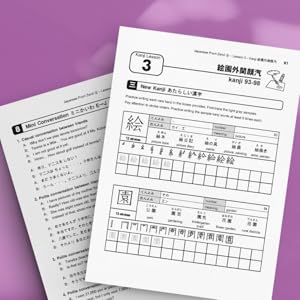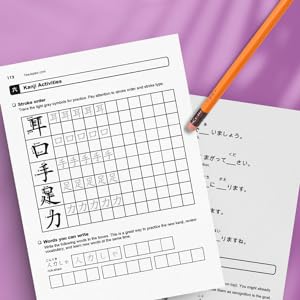Доставить в Belarus
IДля лучшего опыта Получите приложение
Обслуживание клиентов
© 2024 Desertcart Holdings Limited.


Full description not available






B**N
Great series, with one caveat: you need other resources
This entire series of books has been invaluable in my goal of learning Japanese despite having little interaction with native speakers of the language. Its greatest strength is the many, many examples of sentences for each grammatical point. Sure, one can memorize rules, but you need examples on top of examples to get a feel for the language, especially on things like the ga/wa distinction and sentence-ending particles, which are second nature to someone for whom Japanese is their first language but are tough for English speakers because our language has no equivalents. Repetition and examples are also plentiful for the kanji characters -- by the end of this book you will be able to write 160 kanji and should recognize quite a few more when used in common words.The only caveat I have, which gets worse as you go along in the series and the grammar gets more sophisticated, is that it doesn't explain the logic underlying grammar rules. It took me a long time to realize that the fact some verbs could take an object with a "wo" particle while others only the subject "ga" particle or a target with the "ni" particle was not arbitrary but based on whether the verb was transitive or intransitive (there seem to be are a lot more of the latter in Japanese than in English). These books don't even use the term intransitive if I recall correctly.Similarly, the student would be better served if the book used more literal translations, like in Tae Kim's guide. Getting from the Japanese sentence to the English translation shown in the book can be a head-scratcher sometimes. This is particularly true, and this has become more of a problem in book 4, where the sentence requires understanding a grammar point that the series hasn't covered yet! For example, many Japanese particles do double-, triple -, quadruple duty, meaning different things in different clauses or in combination with other particles. Sometimes a sentence in the book, though, will use a particle you've learned but in a way you haven't learned. Many times I've had to consult the book Essential Japanese Grammar to figure out something that this book is neglecting to tell me. Without another grammar book (and a dictionary) I suspect I would be quite frustrated at times. A grammar reference book is also needed because the format of this book, which is meant to be user-friendly to a student (a younger person than me, I'm assuming), makes it inconvenient as a reference work.Despite all this carping, I can't give it less than 5 stars, simply because the sheer volume of material presented at a nice pace makes this series the primary resource for a beginner like myself.
V**M
A great guide to learning slightly more intricate Japanese after Japanese from Zero 3
Japanese from Zero 3 primarily focused on trying to introduce the reader to Kanji as well as how to make slightly less basic sentences with more involved grammar. Japanese from Zero 4 continues your study of kanji while teaching how to make slightly longer, connected and more intricate sentences with actual grammatical structures to learn. After using this book, it will push you close enough into the slightly lower intermediate stage of understanding Japanese. After finishing this book, you will be able to obviously move on to Japanese from Zero 5 or begin to engage with some basic native materials with the help of aids such as a dictionary.Like many have said, the kanji is taught at a snails pace compared to other books, but I believe the author did this with the intention of prioritizing quality over quantity. This book series is clearly meant to be a more accessible and down-to-earth book for learning Japanese and it is an unfortunate fact that dumping a lot kanji to study every chapter will just frustrate and intimidate the average learner. Instead, he teaches the essential kanji and explains a lot of their quirks to teach the reader that kanji is more of a further help than a barrier to understanding Japanese. The reader can then study kanji from other materials more confidently if they need to.Overall, I think this is a great progression from Japanese from Zero 4 and definitely gives the skills needed for Japanese from Zero 5 as well.
G**D
helpful, progressive learning
the book progresses a lot slower than Genki or Minna no Nihongo which is not a bad thing, just a different style, learning a language (esp. one as hard as Japanese) does require a ton of repetition so I found this helpful, I've gone through Genki 1 and 2 and Minna no Nihongo so this book was mostly a review for me but I definitely found it very helpful. I will be buying book 5 as soon as it comes out.another great feature is that the author is striving to make a youtube series that goes over the lessons (currently in progress). this will be a great resource.minor criticisms: many of the kanji readings offered as examples seem too high-level to be useful for a learner at this stage (example: 'satellite broadcasting' or 'railway crossing'). this probably has to do with the fact that it's hard to come up with examples of each reading that are useful for everyday Japanese... I would lean toward not including these examples, if a given reading does not appear in everyday vocabulary maybe leave it out since it won't be important for a beginner anyway. but it's an author choicealso, the pace at which furigana are dropped could be faster.all in all a very enjoyable book and no doubt worth it for the $9.99 (kindle)
K**F
4.5, Great in all But kanji.
This book really makes you take a step forward in the right direction but It really lacks on kanji. there are occasions where you were supposed to see the kanji but they write it down on hiragana. Other times you saw a kanji without furigana that they teach you once in book 3 but you never used nor see again till that point. While I understand that it takes the route of teaching us the same they teach a Japanese student in japan, we don't have the same vocabulary as them so teaching us something we haven't used and that we won't use again in the book seems pointless.Aside from that I'm happy with it, you should always have different sources of study so, in this case, consider looking for one that covers kanji. Some use Waninaki, others use textbooks, you may as well try kanji from zero. I use an app though.
TrustPilot
3 дня назад
3 недели назад